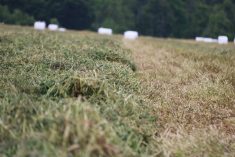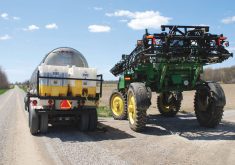If Canadian farmers want to avoid the fate of their U.S. counterparts struggling with glyphosate-resistant weeds such as kochia, waterhemp, and common and giant ragweed, then they’d better practise zero tolerance, says an American weed scientist.
“That means no survival rate and no weed seed production,” researcher Jeff Stachler told attendees at the Manitoba Agronomists Conference last month.
“Can a resistant weed that is not allowed to produce seed cause you a problem down the road? The answer is no.”
Too often, producers are making excuses for weeds that survive herbicide applications rather than jumping on the problem, he said.
Read Also

What is perfect Christmas weather?
What is ‘perfect’ Christmas weather on the Prairies? Here’s where you should head this holiday, according to historical weather data.
“We ignore survival. There are all kinds of excuses — the size of plant, the coverage — but I would argue that only 50 per cent of the reason for any plant to survive a herbicide application are those things,” said Stachler, who works for both the North Dakota State University and University of Minnesota.
“The other half is the genetics as it interacts with the environment. Those parameters and excuses we have been using for years allow more plants to survive and when two of those plants cross, a certain percentage of the next generation will have a higher level of resistance.”
Resistance shouldn’t be confused with tolerance, he said, citing corn and atrazine as an example of tolerance. A corn plant metabolizes atrazine so the herbicide can’t kill it.
“If it’s the majority of the population and 99 per cent of the plants survive, it’s tolerance. If only one per cent or two per cent of the plants survive, then it’s resistance through selection for those and then you are enhancing those individuals over time.”
Difference in resistance
Another issue is that many farmers don’t fully understand or recognize the difference between low-level and high-level resistance, he said.
High-level resistance is survival at greater than 10 times the labelled rate of herbicide and usually there is very minimal injury to plants.
“If you put on the right rate of herbicide in this instance, it doesn’t matter,” he said. “Because even if you choose to go to two times the label rate, you still have survivors because the level of resistance is 10 times the label rate.”
In greenhouse tests, he has found some plants that can survive 1,000 times the typical use rate of a specific herbicide — even when the susceptible check died at one-thousandth the rate. Although this is an extreme example, it shows resistance can become so high, the weed has essentially developed immunity.
It’s a different situation with low-level resistance, where there is always significant injury even though the plants survive.
In this situation, the rate of application is crucial, said Stachler. He used the example of a field where some weeds have resistance up to 1.5 times the recommended application rate. If you put on two times the recommended rate, no weeds will survive. But if you only put on half the rate, a weed with resistance from 0.5 to 1.5 times the normal rate will survive.
And that’s not even the worst part.
“If we just leave those plants out there and they cross-pollinate, a certain percentage of the next generation will have a higher level of resistance than either two parents,” said Stachler.
He said farmers should scout fields between five to 14 days after each herbicide application.
“What you will see is dead plants, and then you will have a normal-appearing plant next to it but again, with low-level resistance, it (will be) injured,” said Stachler. “You may have an injured plant where part of the stem has been killed by the herbicide, but you still have green leaves and some regrowth.”
Examine plants closely
In such situations, you almost certainly have resistant weeds, he said.
Take a close look at every weed, and don’t be fooled by younger, smaller plants which may seem to be dying, but may be capable of recovering.
Missing a single plant can have huge consequences, he added.
One waterhemp plant can produce as many as five million seeds, and the math is frightening even at much lower levels. Stachler used the example of a single weed plant producing 100,000 seeds, with just 25 per cent of them germinating the following year. If 10 per cent are resistant, then there would be 2,500 resistant plants in the field by the end of the next growing season. If nothing is done, then the number would reach 6.25 million resistant plants in year two.
“I am not saying in two years you are going to have 6.25 million resistant plants, but that is a viable possibility, and research in Arkansas has verified this example,” said Stachler.
Also, keep a close eye on the edges of fields and ditches.
“Spray nozzles are set up to have a third overlap on each edge of a flat fan nozzle, so you are not getting a full dosage with that last outside nozzle,” said Stachler. “You are always using a reduced rate of the herbicide on the outside edges of the field. This is a great place for resistance to start developing and that’s why you need to practise zero tolerance, 100 per cent weed control on the edges of the field. Because if you don’t, you are going to have problems.”
Farmers who suspect they have resistant weeds should use any means to remove them that’s ethical, environmental and economical, said Stachler.
If need be, hand weed, he said, adding that 52 per cent of Arkansas cotton is now hand weeded because of glyphosate-resistant Palmer amaranth — although that approach is producing results.
“A 50-acre cotton field was hand weeded and it took 110 hours. At $10-per-hour labour cost that’s $22 an acre. Next year with the same 50 acres and management tactics it took only five hours to hand weed because it had been hand weeded the year before. That’s $1 an acre.”
Above all, keep an open mind and be willing to change management practices, including using herbicides with different modes of action and proper rotation practices, he said.
Stachler recommends both a pre-emergence and post-emergence herbicide application to make sure you have a clean crop and aim to get a quick crop canopy closure. Apply herbicides to plants less than three inches high, and always use recommended rates and any adjuvants that are recommended on the label, also at the correct rates, he said.














